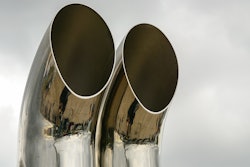This year will be a “continuation of the hot market we’ve enjoyed for several years,” Jim McReynolds, Caterpillar’s general manager of on-highway engines, told attendees at Heavy Duty Dialogue in Las Vegas, Nev. on Monday, Jan. 23. Continued economic growth, low interest and inflation rates and strong carrier profits all contribute to the rosy outlook, he said.
Ninety-five percent of fleets said business in 2006 will be as good or better than last year, and half of respondents said freight will increase, said Reynolds, citing results of a survey conducted by FCC Equipment Finance, a wholly-owned Caterpillar company. Most fleets said capital equipment budgets will stay at present levels, while 25 percent said they will increase. At the same time, 75 percent said truck pricing will increase; one-quarter said these increases will be significant.
As we look toward the introduction of new low-emissions engines in 2007, many fleets said they will deal with concerns about truck pricing and increased cost of operation by extending trade cycles. Estimates are that truck prices could go up another $10,000 in 2007.
When it comes to selecting engines, reliability and fuel economy are fleets’ biggest concerns, Reynolds said. “Some 2002 engines have not performed lately,” he said. “The more complex engines get, the more fearful the market becomes.” Customers will rely on those who have taken care of them in the past, he said.
While all engine makers have had difficulty getting trucks with ’07 technology into customers’ hands, expectations are for fewer problems than with 2002 engines because engine makers have had more time to prepare this time around.
Another challenge is the availability of ultra-low-sulfur diesel to use in testing, he said. With some customers paying up to $4.35 per gallon for ULSD, Caterpillar has subsidized customers to help them test, he said. Experts predict ULSD will have 1 percent less energy content than traditional diesel, which will result in about a 1 percent fuel economy penalty. Cold weather performance and how to store the fuel to avoid contamination are other concerns, as are infrastructure and supply challenges faced by petroleum companies.
Faced with these challenges, fleets are exhibiting the same behavior as they did leading up to the introduction of the 2002 engines, McReynolds said: Delaying purchasing the new technology by pre-buying trucks with existing engines and buying used. “This puts added pressure on the parts and service aftermarket,” he said.
A shortage of about 45,000 technicians will contribute to the problem, he said. At the same time, dealers and repair shops will need to be large enough to take advantage of economies of scale in training, equipment, insurance, etc., “in order to work on these expensive new trucks,” he said.









